



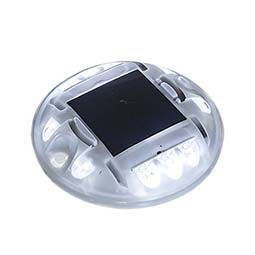
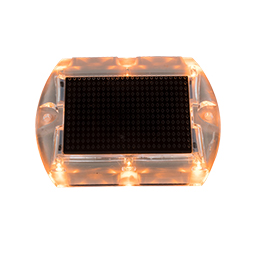
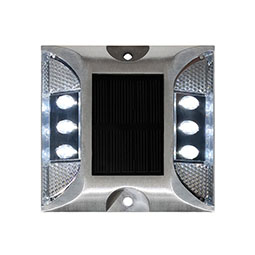
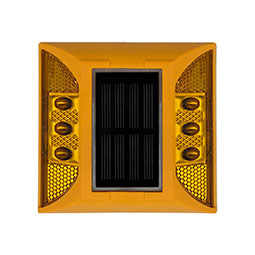
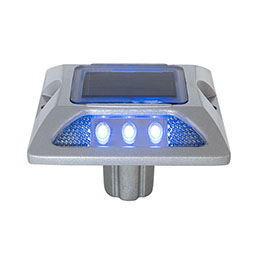
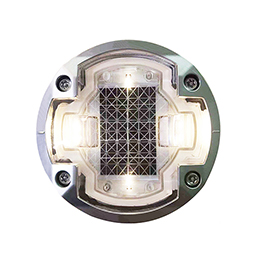
In the road traffic system, lighting and signage play a pivotal role in safety. Especially at night or encountered rain and fog and other inclement weather, clear and accurate road guidance, allows drivers to make timely judgements, effectively avoid accidents, to ensure the smooth passage of the road. Solar cat's eye as an emerging road marking facilities, is relying on its own unique advantages, quietly changing the pattern of road lighting and guidance. Next, this article will analyse the working principle of the solar cat's eye, to help you understand the full range of this practical road safety equipment.
Solar panel is the ‘energy collector’ of the solar cat's eye. Common solar panels are mostly rectangular, the size varies according to different product designs. Their materials are mainly monocrystalline silicon and polycrystalline silicon. Monocrystalline silicon solar panels present a smooth surface with its high purity silicon material and high conversion efficiency; polycrystalline silicon solar panels are made up of multiple silicon crystal particles, which are relatively low cost.
In operation, solar panels are based on the principle of the photoelectric effect. When photons of sunlight hit the surface of the solar panel, electrons in the silicon material gain energy to be excited, resulting in electron - hole pairs. These electrons and holes move directionally under the action of an internal electric field to form an electric current, which in turn converts solar energy into electrical energy, providing the initial electrical input for the entire solar catenary system.
The LED is the light-emitting core of the solar cat's eye. It works on the principle of electroluminescence. When current passes through the LED, electrons and holes are compounded, releasing energy in the form of photons, thus emitting bright light.
LEDs have many advantages. Its energy-saving characteristics are significant, compared with traditional lighting sources, can be lower energy consumption to achieve efficient light. At the same time, it has an extremely long life, up to tens of thousands of hours under normal use, greatly reducing the frequency of replacement of light sources. The fast response time is also a highlight, from receiving the electrical signal to the light-emitting almost instantly. At night or in low-light conditions, the LED converts the power supplied by the energy storage device into light that accurately illuminates key areas such as road contours and lane dividers, providing drivers with clear and intuitive road guidance.
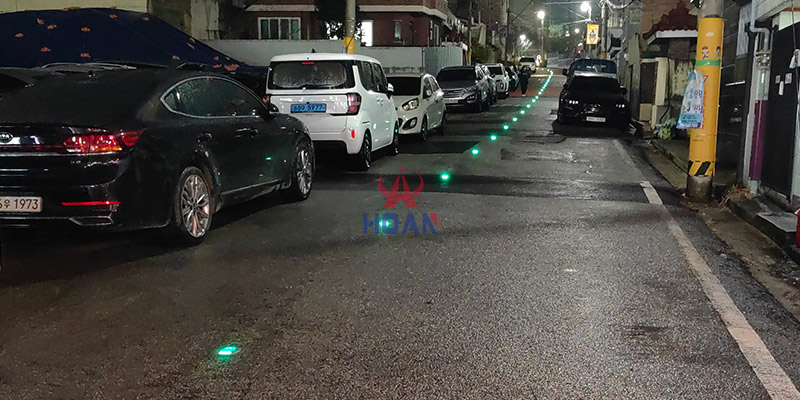
The energy storage device is like the ‘energy warehouse’ of the solar catadioptric eye, and currently the commonly used ones are batteries and capacitors. Batteries are more common with lead-acid and lithium batteries. Lead-acid batteries are lower in cost and mature in technology, but suffer from high weight and relatively short life; lithium batteries, on the other hand, have high energy density, light weight and long life, although they are relatively costly. Capacitors have the advantage of fast charging and discharging, and can quickly store and release energy, but their energy storage density is relatively low.
During the day, the electrical energy generated by solar panels is transmitted to the energy storage device. In the case of a battery, for example, electrical energy is converted to chemical energy and stored through an internal chemical reaction. When night falls or when there is insufficient light, the energy storage device reconverts the stored chemical energy into electrical energy and steadily supplies power to the LEDs, ensuring that the solar cat's eye continues to shine and provide uninterrupted lighting to guide the road.
The housing of the solar cat's eye is responsible for protecting the precision components inside. It is usually made of high-strength, wear-resistant materials such as engineering plastics or metal alloys. Engineering plastics are lightweight, low-cost and corrosion-resistant; metal alloys are stronger and can better withstand external impacts.
The structural design of the shell is very delicate, with good sealing performance, can effectively waterproof, dustproof. Whether it is pouring rain or sand, it can ensure that the internal components are not eroded. At the same time, the shell through a specific structure, such as the bottom of the slot or screw holes, firmly fixed on the road, even in the face of frequent vehicle crushing, but also can always remain stable, to protect the normal work of the solar cat eye.
During the day, when the sunlight sprinkles the earth, the solar panel starts to get busy. Photons continue to hit the surface of the solar panel, stimulating the electrons in the silicon material, producing electron - cavity pairs. These charged particles, driven by an internal electric field, form a direct current. The current is transmitted to the energy storage device via connecting lines.
In the case of a battery, for example, redox reactions occur internally when current flows into the battery. The active substances in the positive and negative electrodes interact with the electrolyte to convert electrical energy into chemical energy for storage. This process is like ‘charging’ the battery to reserve energy for luminosity at night. In clear weather, the solar panels efficiently convert solar energy into electrical energy, quickly charging the energy storage device.
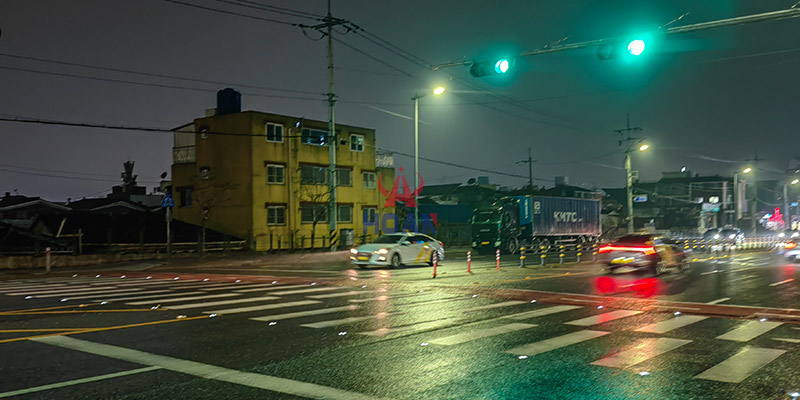
As night falls, the ambient light gradually becomes weaker. The light-control switch in the solar cat's eye (usually composed of a sensing element such as a photosensitive resistor) begins to function. When the ambient light intensity is lower than a specific threshold, usually 100 lux, the resistance value of the photoresistor changes, triggering the circuit to conduct.
At this point, the energy storage device begins to release the stored electrical energy. The electric energy passes through the driver circuit, and the voltage and current are adjusted to suit the working requirements of the LED. The adjusted electrical energy is fed into the LED, which emits bright light based on the electroluminescence principle. These rays of light are emitted at a specific angle through the carefully designed lens or lampshade, clearly outlining the outline of the road, providing drivers with accurate road guidance and enabling them to easily identify the direction of the road in the dark.
The LEDs of the solar cat's eye are characterised by high brightness and directional light emission. Under ideal weather conditions, the light emitted can be clearly seen by drivers at a distance of 900m. Compared with traditional reflective signs, the advantage of solar cat's eye early warning is very obvious. While traditional reflective signs only reflect light when illuminated by vehicle lights, the solar cat's eye emits its own active light, allowing drivers to be aware of road conditions much earlier.
In bad weather, such as pouring rain, dense fog or snowflakes, the advantages of solar cat-eye more prominent. Its light has a strong penetrating ability and will not be easily blocked by rain, fog or snow, and can still provide drivers with effective road guidance, which greatly improves the safety of driving in bad weather.
The solar cat-eye is equipped with a very intelligent light control system that can automatically sense changes in ambient light. Without human intervention, it can accurately control the switch of the solar cat-eye. When the sunlight rises in the early morning and the light intensity exceeds 100 lux, the light control switch automatically cuts off the circuit and the LED stops glowing, while the solar panel starts to charge the energy storage device; in the evening, when the light becomes weak and falls below the threshold, the LED lights up automatically. This automatic operation mode not only reduces the maintenance cost, but also ensures that the Solar Cat Eye works at the right time.
As a renewable energy source, solar energy is inexhaustible. Solar cat-eye uses solar energy to supply power, avoiding the consumption of traditional energy, in line with the current concept of environmental protection. Moreover, in the case of grid failure and large-scale power outage, the solar cat's eye can still work normally and continue to provide lighting and guidance for the road to ensure the normal operation of traffic.
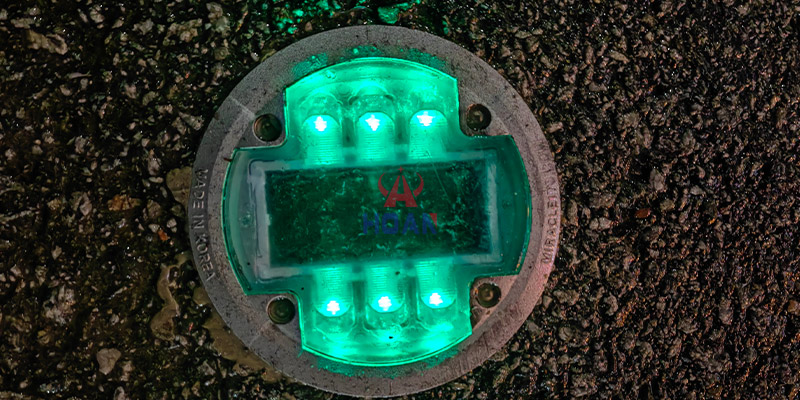
Each component of the solar cat-eye is designed and selected with durability in mind. The sturdy shell is able to withstand long-term vehicle crushing and remain intact even after countless times of heavy pressure from the wheels. The solar panels are made of materials with good UV and weather resistance, which are not easy to deteriorate under the wind and sun, and always maintain a high photoelectric conversion efficiency, and the long-life characteristics of the LEDs reduce the trouble of frequent replacement of the light source.
In different seasons and climatic conditions, the solar cat's eye can maintain stable luminous performance. Whether it is hot summer, or cold winter; whether it is dry inland areas, or wet coastal areas, it can work stably, providing reliable road marking, to protect road traffic safety.
The solar panel collects energy efficiently by means of photoelectric effect; the LED provides clear illumination by means of electroluminescence; the battery and capacitor store and release electric energy; and the strong and sealed shell resists external force and erosion. In terms of workflow, the solar panel is charged during the daytime and the energy storage device accumulates electricity; at night, the light-controlled switch is activated and the electricity drives the LEDs to emit light. Its performance advantages are obvious, greatly enhancing visibility, automatic operation and energy saving, long life and strong stability. It can be seen that the solar cat's eye with scientific principles and excellent characteristics, is for road safety escort, in the future traffic field is bound to play a more critical role.